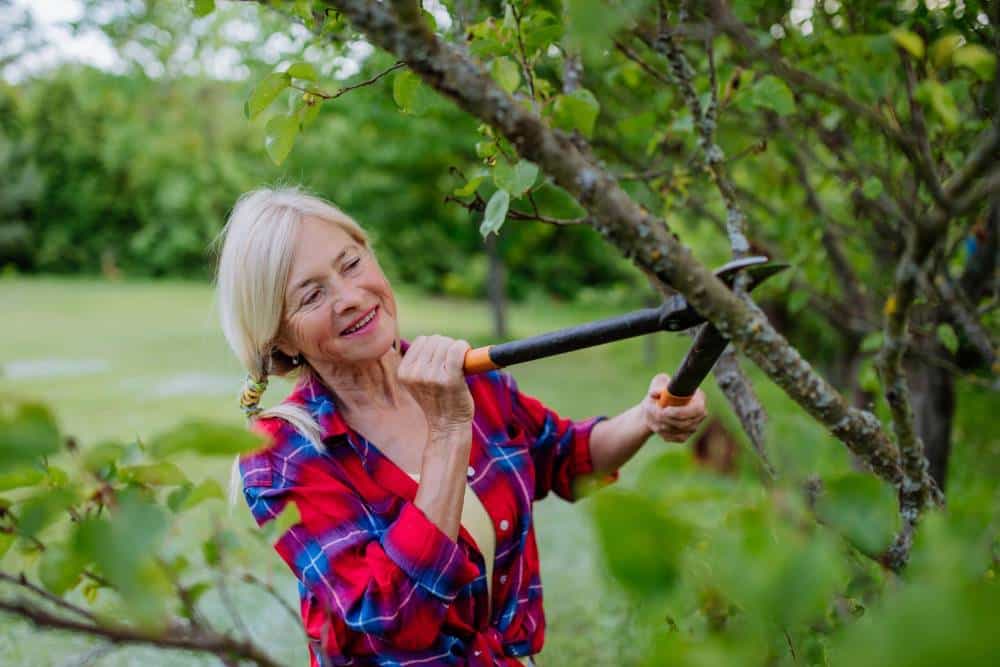
Trees are the focal point of a landscape, providing shade, animal habitats, and majestic beauty. By giving them the attention they need to remain healthy and well-structured, they return the favor in value and longevity.
Shrubs make up the foundational layer of a gardenscape, anchoring the living design and accentuating your home’s lines and architecture. They set the configuration and backdrop for color and texture provided by annuals and perennials.
The arrival of spring provides a great time to inspect your trees, shrubs, and other plants for any winter damage as well as setting them up for a healthy, beautiful summer.
7 tips to make your trees and plants beautiful this spring
Follow these tips for providing the care and attention your garden needs after a long winter.
Clean. Rake up any dead leaves and sticks that have settled around your trees and under shrubs. For trees, rake about three, or so, feet out from tree bases so you’ll have room to take the other steps below. Next, make sure to thoroughly weed around trees and shrubs in preparation for the glory of spring.
- Mulch. Now that the area around the base of your trees and shrubbery is cleaned you can add mulch. Use high-quality mulch that’s not artificially dyed. The dyes used are not good for the soil, even when the mulch is supposedly ‘organic.’ Additionally, avoid ash-infused mulches as they are caustic and can result in nitrogen immobilization because all the nitrogen is being used to break down the mulch, leaving none for the plants to keep leaves beautiful and green.
- When laying down mulch, give a layer of about three to four inches deep around the tree trunk, but be sure to not push it up against the tree. The trunk needs to breathe and moisture held directly against the trunk can contribute to insect and fungal growth… Placing the mulch over the critical root zone of the tree helps the tree retain water, rather than allowing it to run off into the grass or street. It also helps reduce weeds and lawnmower damage.
- Water. Trees and shrubs need regular and thorough watering throughout spring. This will ensure they don’t dry out as the weather continues to warm. For trees specifically, watering depends on the tree’s age. Do not water an established, older tree near or directly on the trunk as the roots have expanded much further out from there. For a younger tree (under three years old), it’s fine to the water near the trunk.
- Prune. Since your greenery has been dormant over the winter, springtime is a great time to remove all dead and diseased branches from trees and any dead branches from hedges and shrubs. For trees, you can also remove stubs leftover from old limbs and cut back branches that may rub together. Be sure to not cut directly against the main trunk – you don’t want to damage the bark there. A
small collar being left will heal on its own. For larger, established trees, it’s best to leave that pruning to professionals as we have the experience and equipment to handle greater heights and access to branches rubbing on a roof or other area of your home. - Fertilize. It’s important to fertilize in spring because that’s when everything is growing and flowering. Fertilization can give trees and shrubs an extra boost for health and growth in springtime. When it comes to trees, you’ll need to provide about 1/4 to 1/2 pounds of nitrogen fertilizer per trunk diameter inch for larger trees. Spread fertilizer along the tree drip line (this is the area underneath the canopy). Punch holes in the surrounding soil with a probe or other slim metal tool to aid in absorption – be careful to not punch holes in the roots! For shrubs and other foundational layer plants, fertilizer amount and type depends on the plant itself. Call us for expert advice or check with your local nursery for information.
- Inspect. If your trees and other greenery are looking sparse and you don’t see a lot of new green growth and/or blossoms budding, something might be wrong. Cracks in trunks or holes may indicate decay. Call a professional arborist to inspect and advise about treatment or removal.
- Plant. Spring is the time to plant colorful annuals and perennials to add vibrancy and bright color to your landscape. It’s also a good time to plant a new tree. After all, spring is the season of freshness, new life, and fresh starts.
Need professional help for your trees and landscape? Call Jarvis Tree Experts for a free, no-obligation quote.
Originally posted 2023-01-26 11:48:34.
Originally posted 2023-01-26 11:48:34.




